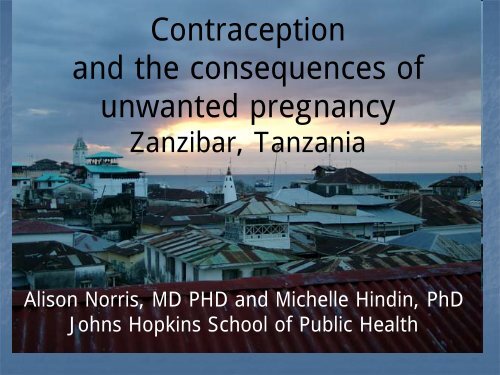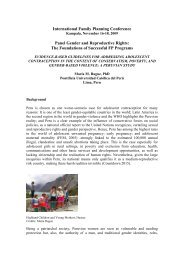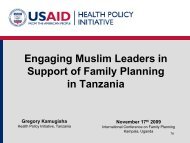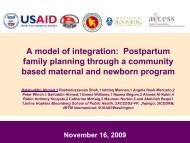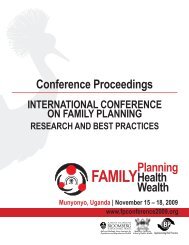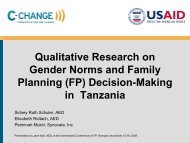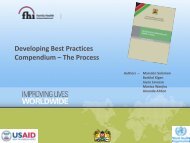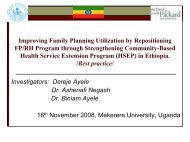Contraception and the consequences of unwanted pregnancy ...
Contraception and the consequences of unwanted pregnancy ...
Contraception and the consequences of unwanted pregnancy ...
You also want an ePaper? Increase the reach of your titles
YUMPU automatically turns print PDFs into web optimized ePapers that Google loves.
<strong>Contraception</strong><br />
<strong>and</strong> <strong>the</strong> <strong>consequences</strong> <strong>of</strong><br />
<strong>unwanted</strong> <strong>pregnancy</strong><br />
Zanzibar, Tanzania<br />
Alison Norris, MD PHD <strong>and</strong> Michelle Hindin, PhD<br />
Johns Hopkins School <strong>of</strong> Public Health
<strong>Contraception</strong>/abortion<br />
connection<br />
lack <strong>of</strong> contraception<br />
<strong>unwanted</strong> pregnancies<br />
unsafe abortions
High unmet contraceptive<br />
need in Tanzania<br />
On mainl<strong>and</strong> Tanzania:<br />
o 24% using modern method<br />
o 22% have unmet need<br />
On Zanzibar:<br />
o 9% using a modern method<br />
o 30% have unmet need<br />
DHS 2004
Groups with most unmet<br />
need for contraception<br />
o Adolescents<br />
o Women fearing health<br />
<strong>consequences</strong> <strong>of</strong> contraception<br />
(especially infertility)<br />
o Women encountering supply<br />
shortages <strong>and</strong> insufficient<br />
contraceptive counseling<br />
Marchant 2004
Abortion in Tanzania <strong>and</strong><br />
Zanzibar<br />
Some women with<br />
<strong>unwanted</strong><br />
pregnancies will<br />
seek to terminate<br />
<strong>the</strong>m<br />
Many methods are<br />
unsafe
Abortion methods, mainl<strong>and</strong><br />
Provider<br />
o Unskilled for 46% rural, 60% urban<br />
Method<br />
o MVA/D&C for 40% rural, 28% urban<br />
o Herbs (vaginal or oral) for 34% rural, 51%<br />
urban<br />
o Ca<strong>the</strong>ter/roots in cervix for 21% rural, 12%<br />
urban<br />
Most complications seen with ca<strong>the</strong>ter/roots<br />
o Rasch 2009
Goals <strong>of</strong> <strong>the</strong> research, 1<br />
to underst<strong>and</strong><br />
community<br />
norms around<br />
contraception,<br />
<strong>unwanted</strong><br />
<strong>pregnancy</strong>, <strong>and</strong><br />
abortion
Goals <strong>of</strong> <strong>the</strong> research, 2<br />
to evaluate<br />
women’s<br />
experiences<br />
with abortion<br />
<strong>and</strong> <strong>the</strong>ir unmet<br />
need for<br />
contraception
Goals <strong>of</strong> <strong>the</strong> research, 3<br />
to collaborate<br />
on <strong>pregnancy</strong><br />
prevention<br />
<strong>and</strong> abortion<br />
safety<br />
programs
Multi-method Multi method study<br />
o Community discussions (n=120)<br />
o Community opinion leaders (n=24)<br />
o Providers (n=20)<br />
o Women who have had abortions<br />
(n=50)<br />
o Post-abortion care patients (n=300)
Multi-method Multi method study<br />
o Community discussions (n=120)<br />
o Community opinion leaders (n=24)<br />
o Providers (n=20)<br />
o Women who have had abortions<br />
(n=50)<br />
o Post-abortion care patients (n=300)
Multi-method Multi method study<br />
o Community discussions (n=120)<br />
o Community opinion leaders (n=24)<br />
o Providers (n=20)<br />
o Women who have had abortions<br />
(n=50)<br />
o Post-abortion care patients (n=300)
Multi-method Multi method study<br />
o Community discussions (n=120)<br />
o Community opinion leaders (n=24)<br />
o Providers (n=20)<br />
o Women who have had abortions<br />
(n=50)<br />
o Post-abortion care patients (n=300)
Multi-method Multi method study<br />
o Community discussions (n=120)<br />
o Community opinion leaders (n=24)<br />
o Providers (n=20)<br />
o Women who have had abortions<br />
(n=50)<br />
o Post-abortion care patients (n=300)
Preliminary situation analysis<br />
Why is contraceptive prevalence so<br />
low?<br />
What happens to <strong>unwanted</strong><br />
pregnancies?
Social change for FP<br />
o religious leader field trips<br />
o community outreach<br />
o provision <strong>of</strong> commodities<br />
o Supply <strong>and</strong> privacy are paramount<br />
for patients
Abortion contributes to<br />
morbidity <strong>and</strong> mortality<br />
Admissions to hospital<br />
gynecologic surgical<br />
ward (2007-2009):<br />
o 42% <strong>of</strong> 10,000 total<br />
admissions were<br />
“abortion admissions”<br />
(>100/month)
Abortion contributes to<br />
morbidity <strong>and</strong> mortality<br />
Maternal mortality<br />
on Zanzibar:<br />
o 407 deaths per<br />
100,000 live<br />
births<br />
o abortion is <strong>the</strong><br />
cause for 3%
Some availability <strong>of</strong><br />
safer abortion<br />
o in private clinics<br />
o relatively expensive at US$40<br />
o common (50-60/month)<br />
o both MVA <strong>and</strong> misoprostol are<br />
used
Post abortion care<br />
as harm reduction<br />
o Can PAC be a stepping stone for<br />
safe abortion?<br />
o MVA <strong>and</strong> D&C possible in 20<br />
facilities (though procedures are<br />
actually happening in only a few)<br />
o Misoprostol for incomplete abortion
Challenges <strong>and</strong><br />
opportunities<br />
o create participant belief about<br />
confidentiality to allow honesty<br />
o research team<br />
o physical space to interview women<br />
who have had abortions<br />
o local champions for <strong>the</strong> data
Challenges <strong>and</strong><br />
opportunities<br />
o identify areas for improved<br />
programming for family planning<br />
o individual (counseling)<br />
o community (social norms)<br />
o structural (laws <strong>and</strong> commodities)<br />
o develop opportunities for safer<br />
abortion


